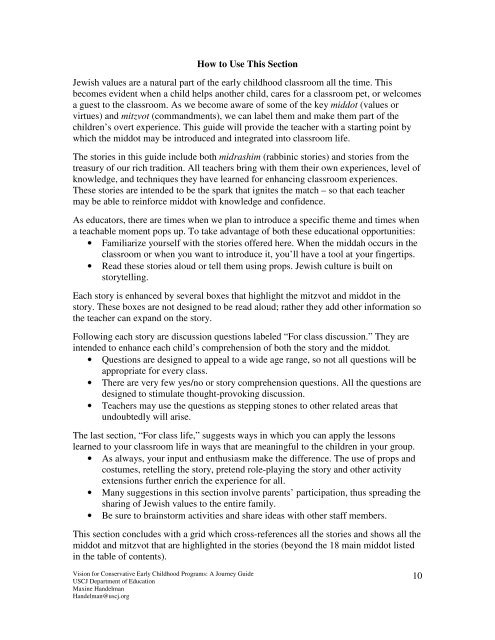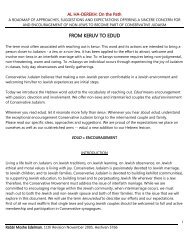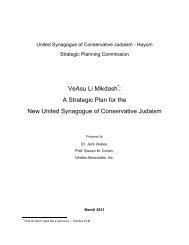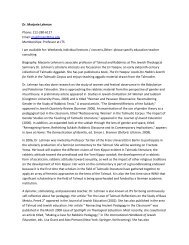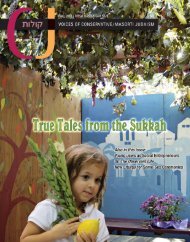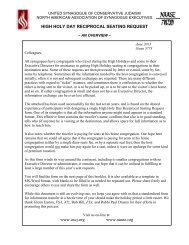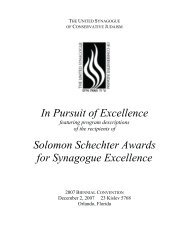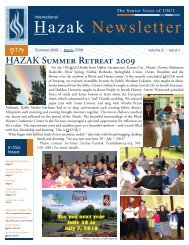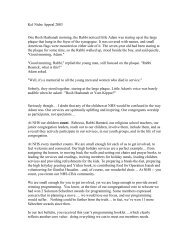Vision for Conservative Early Childhood Programs: A Journey Guide
Vision for Conservative Early Childhood Programs: A Journey Guide
Vision for Conservative Early Childhood Programs: A Journey Guide
You also want an ePaper? Increase the reach of your titles
YUMPU automatically turns print PDFs into web optimized ePapers that Google loves.
How to Use This Section<br />
Jewish values are a natural part of the early childhood classroom all the time. This<br />
becomes evident when a child helps another child, cares <strong>for</strong> a classroom pet, or welcomes<br />
a guest to the classroom. As we become aware of some of the key middot (values or<br />
virtues) and mitzvot (commandments), we can label them and make them part of the<br />
children’s overt experience. This guide will provide the teacher with a starting point by<br />
which the middot may be introduced and integrated into classroom life.<br />
The stories in this guide include both midrashim (rabbinic stories) and stories from the<br />
treasury of our rich tradition. All teachers bring with them their own experiences, level of<br />
knowledge, and techniques they have learned <strong>for</strong> enhancing classroom experiences.<br />
These stories are intended to be the spark that ignites the match – so that each teacher<br />
may be able to rein<strong>for</strong>ce middot with knowledge and confidence.<br />
As educators, there are times when we plan to introduce a specific theme and times when<br />
a teachable moment pops up. To take advantage of both these educational opportunities:<br />
• Familiarize yourself with the stories offered here. When the middah occurs in the<br />
classroom or when you want to introduce it, you’ll have a tool at your fingertips.<br />
• Read these stories aloud or tell them using props. Jewish culture is built on<br />
storytelling.<br />
Each story is enhanced by several boxes that highlight the mitzvot and middot in the<br />
story. These boxes are not designed to be read aloud; rather they add other in<strong>for</strong>mation so<br />
the teacher can expand on the story.<br />
Following each story are discussion questions labeled “For class discussion.” They are<br />
intended to enhance each child’s comprehension of both the story and the middot.<br />
• Questions are designed to appeal to a wide age range, so not all questions will be<br />
appropriate <strong>for</strong> every class.<br />
• There are very few yes/no or story comprehension questions. All the questions are<br />
designed to stimulate thought-provoking discussion.<br />
• Teachers may use the questions as stepping stones to other related areas that<br />
undoubtedly will arise.<br />
The last section, “For class life,” suggests ways in which you can apply the lessons<br />
learned to your classroom life in ways that are meaningful to the children in your group.<br />
• As always, your input and enthusiasm make the difference. The use of props and<br />
costumes, retelling the story, pretend role-playing the story and other activity<br />
extensions further enrich the experience <strong>for</strong> all.<br />
• Many suggestions in this section involve parents’ participation, thus spreading the<br />
sharing of Jewish values to the entire family.<br />
• Be sure to brainstorm activities and share ideas with other staff members.<br />
This section concludes with a grid which cross-references all the stories and shows all the<br />
middot and mitzvot that are highlighted in the stories (beyond the 18 main middot listed<br />
in the table of contents).<br />
<strong>Vision</strong> <strong>for</strong> <strong>Conservative</strong> <strong>Early</strong> <strong>Childhood</strong> <strong>Programs</strong>: A <strong>Journey</strong> <strong>Guide</strong><br />
USCJ Department of Education<br />
Maxine Handelman<br />
Handelman@uscj.org<br />
10


